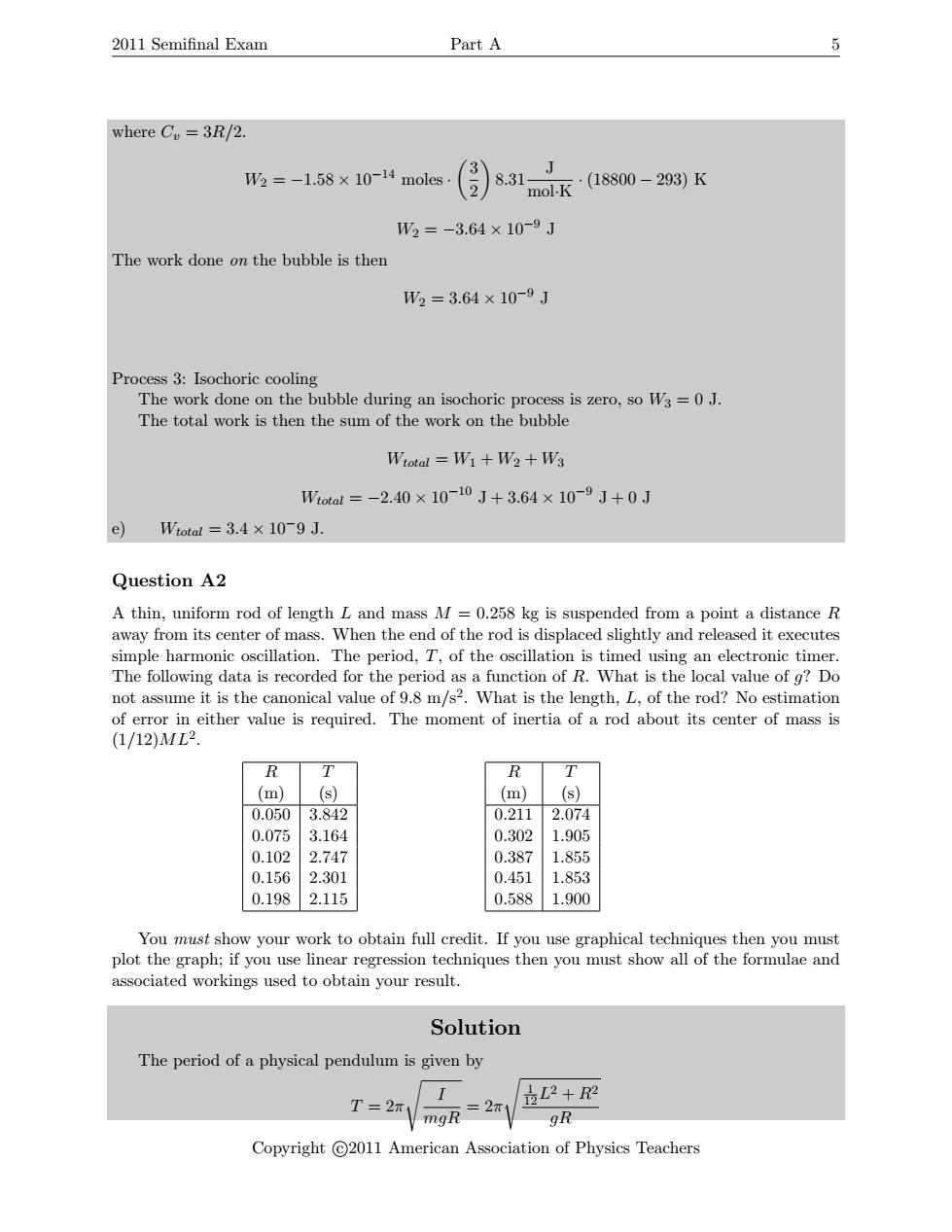正在加载图片...

2011 Semifinal Exam Part A 5 where C=3R/2. W2=-1.58×10-14 moles 2 831J mol.K ·(18800-293)K W3=-3.64×10-9J The work done on the bubble is then W2=3.64×10-9J Process 3:Isochoric cooling The work done on the bubble during an isochoric process is zero,so W3=0J. The total work is then the sum of the work on the bubble Wtotal W1 W2 W3 Witotal=-2.40×10-10J+3.64×10-9J+0J e) Wtotal=3.4×109J. Question A2 A thin,uniform rod of length L and mass M=0.258 kg is suspended from a point a distance R away from its center of mass.When the end of the rod is displaced slightly and released it executes simple harmonic oscillation.The period,T,of the oscillation is timed using an electronic timer. The following data is recorded for the period as a function of R.What is the local value of g?Do not assume it is the canonical value of 9.8 m/s2.What is the length,L,of the rod?No estimation of error in either value is required.The moment of inertia of a rod about its center of mass is (1/12)ML2. R T R (m) (s) (m) (s) 0.050 3.842 0.211 2.074 0.075 3.164 0.302 1.905 0.102 2.747 0.387 1.855 0.156 2.301 0.451 1.853 0.198 2.115 0.588 1.900 You must show your work to obtain full credit.If you use graphical techniques then you must plot the graph;if you use linear regression techniques then you must show all of the formulae and associated workings used to obtain your result. Solution The period of a physical pendulum is given by I T=2r1 mgR= 2π bL2+必 9R Copyright C2011 American Association of Physics Teachers2011 Semifinal Exam Part A 5 where Cv = 3R/2. W2 = −1.58 × 10−14 moles · 3 2 8.31 J mol·K · (18800 − 293) K W2 = −3.64 × 10−9 J The work done on the bubble is then W2 = 3.64 × 10−9 J Process 3: Isochoric cooling The work done on the bubble during an isochoric process is zero, so W3 = 0 J. The total work is then the sum of the work on the bubble Wtotal = W1 + W2 + W3 Wtotal = −2.40 × 10−10 J + 3.64 × 10−9 J + 0 J e) Wtotal = 3.4 × 10−9 J. Question A2 A thin, uniform rod of length L and mass M = 0.258 kg is suspended from a point a distance R away from its center of mass. When the end of the rod is displaced slightly and released it executes simple harmonic oscillation. The period, T, of the oscillation is timed using an electronic timer. The following data is recorded for the period as a function of R. What is the local value of g? Do not assume it is the canonical value of 9.8 m/s2 . What is the length, L, of the rod? No estimation of error in either value is required. The moment of inertia of a rod about its center of mass is (1/12)ML2 . R T (m) (s) 0.050 3.842 0.075 3.164 0.102 2.747 0.156 2.301 0.198 2.115 R T (m) (s) 0.211 2.074 0.302 1.905 0.387 1.855 0.451 1.853 0.588 1.900 You must show your work to obtain full credit. If you use graphical techniques then you must plot the graph; if you use linear regression techniques then you must show all of the formulae and associated workings used to obtain your result. Solution The period of a physical pendulum is given by T = 2π s I mgR = 2π s 1 12L2 + R2 gR Copyright c 2011 American Association of Physics Teachers